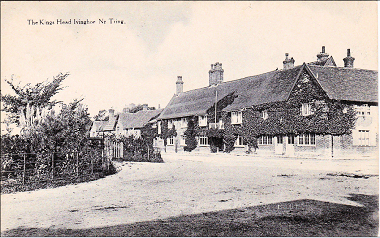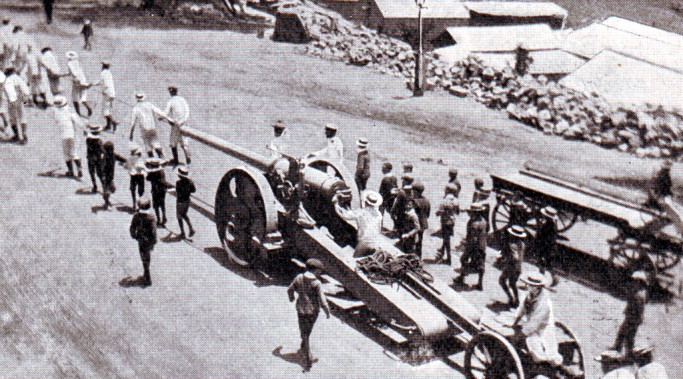|
The 2nd London Heavy Brigade, Royal Garrison Artillery |
|
|
When I was researching for the book, The London Gunners come to Town, one of the units I was interested in was the 2nd London Heavy Brigade. At Christmas 1914 they were stationed at Langley Lodge, Kings Langley, where they were entertained with a good Christmas meal and received gifts of scarves, mittens, tobacco and cigarettes. They sailed for France on the 15th March, 1915, under Major H. B. Brown and, unlike the other artillery units did not stay with the main Division but immediately moved to the Béthune area and went into action behind Neuve Chapelle. They were then ordered north to Ypres on 1st April to assist the Indian Corps. Because they were not with the rest of the Division I didn't follow them further when writing the book. What I had missed when writing the book was that for a time the Brigade moved from the Kings Langley Area to Ivinghoe, just over the county boundary into Bucks, as the following account from the Bucks Herald shows. |
Extracts from the Bucks Herald of 13th February, 1915
Edited from British Newspaper Archive
|
IVINGHOE. MILITARY MOVEMENTS The usually quiet, every-day life of Ivinghoe and Pitstone has been quite the arrival a Battery of the 2nd London Heavy Brigade. R.G.A.. under the command of Major Brown, their headquarters being for the present at the King's Head Hotel, and the N.C.O.’a and men being billeted out in the neighbourhood. The Battery has very smart, workmanlike appearance, and great interest was taken in the guns, which are the original 4.7 guns which played such an important part in the defence of Ladysmith during the Boer War. Since their arrival the firing battery, with the first line of waggons, have been to Salisbury Plain for firing tests, prior to proceeding to active service, which were passed with satisfactory results. With such a large number of young fellows suddenly placed in a country place, it naturally became important question as to where they should spend their evenings, and with this object in view a committee was formed, consisting of the Rev. T. Harvey (chairman), Messrs. H. M. Roberts, R. M. Roberts, E. J. Seabrook, and Jos. Hawkins, with Capt. Lowe, Capt. Scott, and Lieut. Field. After inspecting various buildings, it was decided to approach the Salvation Army authorities with a view to utilising the barracks. The necessary permission having been obtained, steps were at once taken to make the building comfortable. A piano was obtained, together with temporary acetylene gas lighting apparatus, kindly lent by Mr. Roberts, who also had a platform erected, the walls being prettily decorated with flags, etc. The outcome was very hospitable-looking room. Light refreshments, of tea, coffee, etc., can obtained: also various games and reading matter being provided. An informal opening took place on Feb. 3rd, the chair being taken the Vicar, who was supported by the committee and other officers of the Battery, the hall being filled with N.C.O.'s and men. The Chairman, in declaring the hall open, said how pleased they were to welcome the men to Ivinghoe, and hoped that while they were amongst them they would enjoy themselves, and existing between the soldiers and parishioners would be maintained. The Vicar also hoped they would come again to Ivinghoe in the summer-time, for he could assure them that Ivinghoe was very pretty place at that season of the year. If they did, he trusted it would under peaceable conditions. Capt. Lowe, on behalf the Battery, thanked the Chairman for his kind remarks, and trusted that all would enjoy themselves while in Ivinghoe. The expense of the hall are being met by voluntary contributions, and it is open from 12 to 9 p.m., no charge being made for admittance. |
The Kings Head Hotel Ivinghoe, Bucks, circa 1910 Brigade H.Q. in February 1915
... There was one episode of respite for the British. A train arriving in the morning brought a number of naval guns and personnel from HMS Powerful in Durban; 280 officers and sailors, four long naval 12 pounders and two 45 pounder 4.7 inch guns mounted on field gun carriages devised by Captain Percy Scott RN. One 12 pounder was put out of action but another put a round on the Long Tom and rendered it inoperative. ... Picture and text from The Battle of Ladysmith |
|
What I hadn't discovered when writing my book was that the gun the Brigade was supplied with was on of the guns involved in the battle of Ladysmith. While I have not established a direct link with the gun at Ladysmith two of the officers who came to Hemel Hempstead at fought as members of the Royal Garrison Artillery, and had been in South Africa during the Boer War. They were: Lieutenant Colonel Edwin Henry Ethelbert Collen - He was very much involved in the arrangement to bring the 2n London Division to the St Albans area when was was declared, and was based at the headquarters in the Peahen Hotel, St Albans. He kept an excellent diary which was quoted extensively in the London Gunners book - and a number of extracts are repeated on this web site. He was awarded the D.S.O. as a result of his actions in the Boer War. Lieutenant Robert Joseph Machugh - He was the commanding officer of the 6th London Brigade, RFA during the time the troops were training in Hemel Hempstead. Had joined the 1st City of London Royal Garrison Artillery in 1895, but in civilian life he was war correspondent for the Daily Telegraph. |
|
February 2015 |
Page Created |


